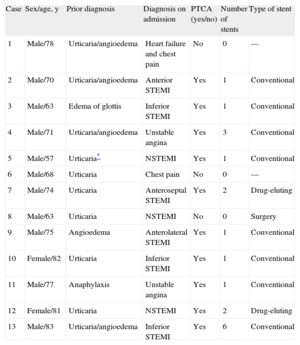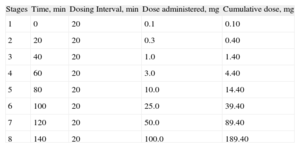Antiplatelet agents, which have been reviewed recently in the Revista Española de Cardiología, and acetylsalicylic acid in particular, are essential for the treatment of ischemic heart disease, especially in the secondary prevention setting.1 Hypersensitivity reactions to acetylsalicylic acid,2 whether allergic (IgE-mediated) or pseudoallergic (caused by a nonimmunologic mechanism) should not be considered as an absolute contraindication because desensitization protocols can be used to permit safe administration.3 Although these protocols are based on administration of increasing doses of the drug until tolerance is achieved, they differ in the initial dose, dosing interval, and the size of the increase at each stage. In addition, they are not standardized or generalized for patients with coronary artery disease, even though acetylsalicylic acid is particularly important and beneficial for patients undergoing coronary intervention, above all if the clinical presentation (acute coronary syndrome) requires an early therapeutic intervention.
In view of the above, and given the little experience published to date, it is not surprising that clinical practice guidelines make no recommendations on the topic. A study performed recently in the United Kingdom revealed that only 12.5% of British centers had local acetylsalicylic acid desensitization protocols. The most common approach (reported by 72% of the participating sites) was to increase the dose of thienopyridines in patients with acetylsalicylic acid hypersensitivity who had undergone percutaneous revascularization.4
Our study complements and extends the experience published previously in Revista Española de Cardiología.5 We studied more patients, including those in whom drug-eluting stents were used, and the most feared complication of acetylsalicylic acid allergy, anaphylaxis, is dealt with.
We prospectively collected data from 13 patients who were admitted to our department between January 2010 and September 2013 with an indication for coronary angiography (Table 1). To be included, patients had to have a history of suspected or known pseudoallergic reactions (nonsteroidal antiinflammatory drugs-induced urticaria-angioedema in asymptomatic patients) or allergic reactions (urticaria-angioedema or anaphylaxis induced selectively by an nonsteroidal antiinflammatory drugs, in this case by salicylates) to acetylsalicylic acid. Eleven of the patients were admitted for acute coronary syndrome. Chest pain suggestive of coronary origin in 1 patient and decompensation of heart failure with chest pain in another patient were the other presenting complaints. Twelve had a history of documented or suspected hypersensitivity to acetylsalicylic acid, whether manifest as cutaneous reactions (urticaria and/or angioedema, 11 patients) or systemic reactions (anaphylaxis, 1 patient). The other patient had a clinical picture of acute urticaria after administration of acetylsalicylic acid on admission.
Characteristics of the Patients Studied
| Case | Sex/age, y | Prior diagnosis | Diagnosis on admission | PTCA (yes/no) | Number of stents | Type of stent |
| 1 | Male/78 | Urticaria/angioedema | Heart failure and chest pain | No | 0 | — |
| 2 | Male/70 | Urticaria/angioedema | Anterior STEMI | Yes | 1 | Conventional |
| 3 | Male/63 | Edema of glottis | Inferior STEMI | Yes | 1 | Conventional |
| 4 | Male/71 | Urticaria/angioedema | Unstable angina | Yes | 3 | Conventional |
| 5 | Male/57 | Urticaria* | NSTEMI | Yes | 1 | Conventional |
| 6 | Male/68 | Urticaria | Chest pain | No | 0 | — |
| 7 | Male/74 | Urticaria | Anteroseptal STEMI | Yes | 2 | Drug-eluting |
| 8 | Male/63 | Urticaria | NSTEMI | No | 0 | Surgery |
| 9 | Male/75 | Angioedema | Anterolateral STEMI | Yes | 1 | Conventional |
| 10 | Female/82 | Urticaria | Inferior STEMI | Yes | 1 | Conventional |
| 11 | Male/77 | Anaphylaxis | Unstable angina | Yes | 1 | Conventional |
| 12 | Female/81 | Urticaria | NSTEMI | Yes | 2 | Drug-eluting |
| 13 | Male/83 | Urticaria/angioedema | Inferior STEMI | Yes | 6 | Conventional |
NSAID, nonsteroidal antiinflammatory drug; NSTEMI, non-ST-elevation myocardial infarction; PTCA, percutaneous transluminal coronary angioplasty; STEMI, ST-elevation myocardial infarction.
Patient 5, who had no history of adverse reactions to nonsteroidal antiinflammatory drugs, experienced an urticaria-type reaction during admission after receiving acetylsalicylic acid.
Ten patients underwent percutaneous revascularization (all admitted for acute coronary syndrome, 6 with ST-elevation myocardial infarction, 2 with non-ST-elevation myocardial infarction, and 2 with unstable angina). One patient was surgically revascularized because his coronary anatomy ruled out percutaneous intervention. Revascularization was not performed in a further 2 patients (patient 1 did not undergo coronary angiography because an exercise echocardiography study with optimized medical treatment was negative for ischemia and patient 6 had no evidence of coronary artery disease). Acetylsalicylic acid treatment was only discontinued in patient 6, when the absence of ischemic origin was confirmed. Patient 11 had a history of ischemic heart disease and substantial vascular disease (history of strokes, without sequelae, and a femoropopliteal bypass due to leg ischemia) in treatment with clopidogrel alone; allergists and cardiologists took the joint decision that the potential benefit outweighed the risks given the clinical profile and coronary anatomy.
After obtaining informed consent, we applied an 8-stage desensitization protocol consisting of oral administration of progressively higher doses of acetylsalicylic acid (Table 2). We interrupted administration of β-blockers 24hours prior to the procedure and monitored vital signs and oxygen saturation at baseline and prior to each dose increase. If a reaction occurred, antihistamines, corticosteroids, bronchodilators, and/or adrenaline were administered according to the severity of symptoms. Once the patient was stable, the protocol was restarted by either repeating with the same dose that caused the reaction or returning to the preceding dose.
Eight-Stage Acetylsalicylic Acid Desensitization Protocol
| Stages | Time, min | Dosing Interval, min | Dose administered, mg | Cumulative dose, mg |
| 1 | 0 | 20 | 0.1 | 0.10 |
| 2 | 20 | 20 | 0.3 | 0.40 |
| 3 | 40 | 20 | 1.0 | 1.40 |
| 4 | 60 | 20 | 3.0 | 4.40 |
| 5 | 80 | 20 | 10.0 | 14.40 |
| 6 | 100 | 20 | 25.0 | 39.40 |
| 7 | 120 | 20 | 50.0 | 89.40 |
| 8 | 140 | 20 | 100.0 | 189.40 |
Increasing doses of acetylsalicylic acid were administered every 20minutes, starting at a dose of 0.1mg and reaching a total cumulative dose of 189.4mg of acetylsalicylic acid at the end of desensitization. This desensitization protocol would be adequate only for patients with allergic or pseudoallergic skin reactions induced by nonsteroidal antiinflammatory agents, and only if the maintenance dose required is 100mg. The only absolute contraindication for desensitization is the presence of Stevens-Johnson syndrome, toxic epidermal necrolysis, drug reaction with eosinophilia and systemic symptoms, or fixed drug eruption.
This protocol was performed prior to the interventional procedure (7 patients) or within 48hours of revascularization in patients admitted for ST-elevation acute myocardial infarction (6 patients). One patient (with no prior history of drug allergy) developed an urticaria-like reaction after administration of the drug and revascularization, and so the desensitization protocol was followed. Antileukotrienes (24hours before and 1 hour before) and dexchlorpheniramine (1 hour before) were administered as premedication in the patient with a history of prior anaphylaxis. The protocol, which we applied in the Intensive Cardiology Care Unit but which could equally well have been applied in the hospital ward according to our results, had a successful outcome in all cases, with no reactions or complications of any type. Dose modifications or an increased interval between doses were not required. A daily dose of 100mg of acetylsalicylic acid was maintained. Likewise, during follow-up, which lasted a median of 27.5 months (interquartile range, 10 to 40 months), no complications were reported.
The patients were to take acetylsalicylic acid daily without interruptions, which might have led to a loss of tolerance after between 2 and 5 days in the case of pseudoallergic reactions and after 24hours in the case of allergic reactions.6 To become tolerant once again, a repeat desensitization procedure would have been needed.
Our study applied a single, standard desensitization protocol in patients with a history of skin reactions or anaphylaxis, regardless of whether the mechanism was immunologic. Sensitivity to acetylsalicylic acid is a serious condition. However, whatever the underlying mechanism and clinical manifestation, such sensitivity should not, we believe, rule out use of this drug in patients with ischemic heart disease, whether during the acute phase of the disease or in the prevention of new events, if the benefits are thought to outweigh the potential risks. The rapid desensitization protocol, as practiced in our center in these patients, has shown a good safety and efficacy profile. This allows the protocol to be used for acetylsalicylic acid without short or long-term complications.


